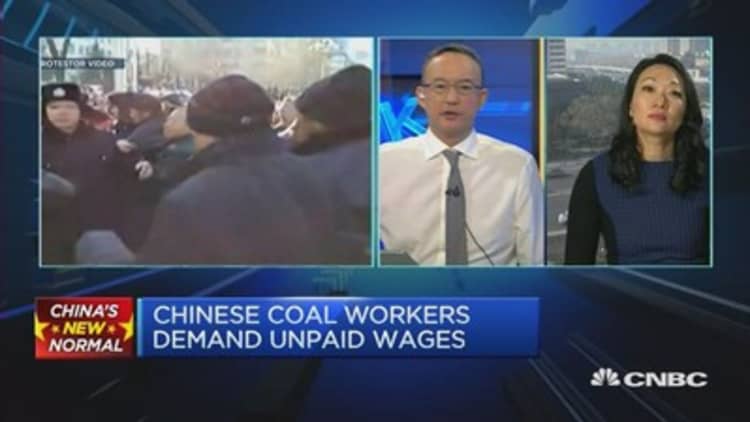
Thousands of Chinese coal miners have taken to the streets in a city near the Siberian border to protest against unpaid wages, in the first direct challenge to Beijing's plan for orderly downsizing and job cuts in the state-owned coal sector.
Beijing has said it would lay aside Rmb100bn ($15.4bn) to "resettle" coal and steel workers as part of a plan to cut unproductive capacity in both sectors, but local governments and the companies themselves are supposed to bear a portion of the costs.
Slowing Chinese growth and the end of the commodities supercycle have turned overcapacity into a pressing economic issue for Beijing. Data published this weekend showed that in the first two months of this year, Chinese production of thermal coal and steel both fell 6 per cent while output of metallurgical, or coking, coal — the steel ingredient produced by the protesting miners — dropped 10 per cent.
Miners at state-owned Shuangyashan Mine, one of four mines that make up ailing Longmay Coal, began a third day of protests holding banners that read "We want to eat, we want our wages" and "Lu Hao lies with his eyes open" referring Mr Lu, the provincial governor of Heilongjiang province.
Last week Mr Lu said that Longmay had met all its salary obligations and criticised the company, which is rapidly becoming the poster child for lossmaking state-owned coal groups, for its lack of productivity.
One protesting miner in Shuangyashan told the Financial Times: "He said during the National People's Congress that Heilongjiang had not delayed payments to its 80,000 coal miners. Well, at the time he said that, we had not gotten our salaries for four months. That's the key." He did not give his name as Chinese authorities regularly imprison workers who lead protests or speak to foreign media.
More from the Financial Times :
What are the economic consequences of Brexit?
Bond markets reopen for EM borrowers
At least 34 killed in Ankara car bomb
Mr Lu then said he had been "misinformed" about Longmay's wage arrears problem. He is the youngest member of the Communist party's Central Committee and was considered a rising star among China's younger leaders during the previous administration of Hu Jintao.
Chinese authorities had been loathe to allow lossmaking state-owned groups to go bankrupt, in part because of the possibility of mass unrest of the type that paralyzed the rust-belt north-east during the previous round of restructuring, in the late 1990s.
Xiao Yaqing, the head of the State Assets Supervision and Administration Commission, told reporters on Saturday: "Those of us who lived through the 1990s know that it was very different", in part because China's economy was much smaller than it is today.
He added: "More mergers mean less bankruptcies and can help us peacefully resolve any disputes. I don't think we will see any return to the 1990s."

Beijing's plan involves trimming excess capacity across the board while allowing the companies themselves to survive or merge into even larger entities. However, the result can be large but weak state-owned companies such as Longmay, which was formed by merging four state-owned coal mines about a decade ago.
The Chinese coal sector is split between privately- or locally-owned smaller miners and enormous state-owned mines, many first developed before the Communist victory in the Chinese civil war. Many of the state-owned mines are lossmaking in part because they are contractually obliged to provide coal at below-market prices to the state-owned power and steel sectors while maintaining bloated work forces and social services as a legacy of their importance to the planned economy.


